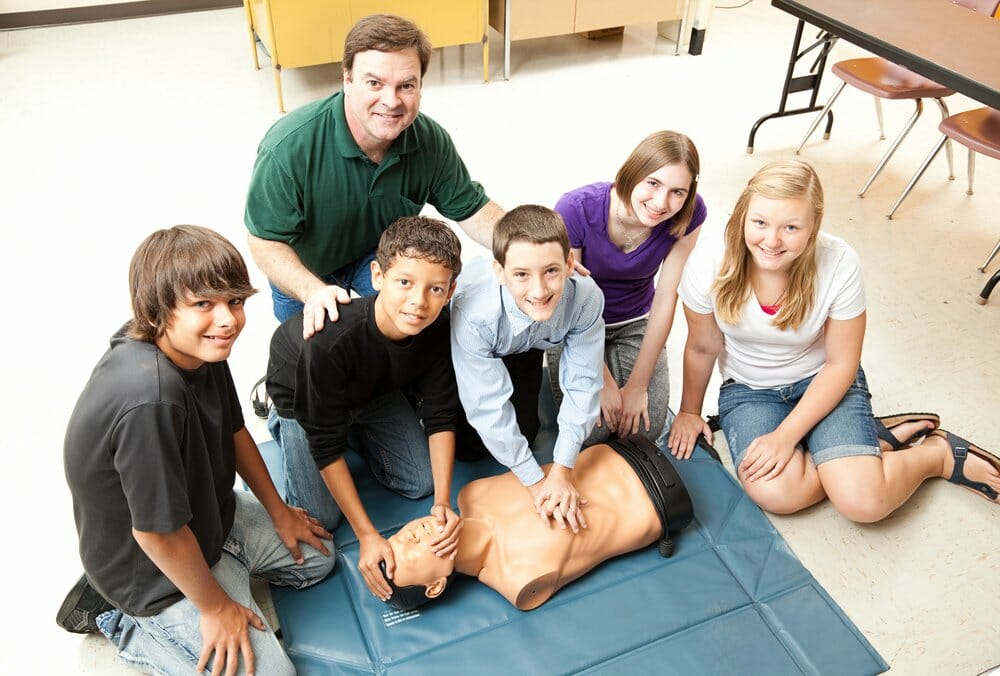
Last Updated On: noviembre 26, 2024
Cardiopulmonary resuscitation, commonly referred to as CPR, is an important life-saving skill that everyone should know. Through a combination of chest compressions and rescue breaths, a bystander can significantly improve the survival rate of a cardiac arrest victim. CPR can also be beneficial for victims of choking, smoke inhalation, near drowning, poisoning, or electrocution injuries. Because this life-saving procedure is so effective and so easy to use, we advocate that everyone should receive their CPR certification.
But should a CPR class be a requirement for the teachers, staff, and even students in schools? The trend for CPR certification is rising throughout the country and certain private companies and industries are even helping out by providing certification. But still, more needs to be done to combat the number of lives lost to cardiac arrest. Every year, over 475,000 American lives are lost to cardiac arrest. If CPR training and certification became mandatory in schools, and even workplaces, this number could be dramatically reduced.
CPR is an effective method for responding to cardiac arrest victims, ensuring that blood and oxygen continue to circulate throughout the body. If the brain is starved of oxygen for even just minutes, permanent damage can occur. Chest compressions keep blood circulating when the heart is unable to perform this function, while rescue breaths deliver much needed oxygen. While this combination of CPR steps has been proven effective, hands-only CPR can also greatly increase a victim’s survival rate.
There are several benefits to teaching CPR in schools. Here are some of the top reasons we advocate for this cause:
The most obvious benefit of training more people in CPR is that it will save lives. Every year, over 350,000 cardiac arrest episodes occur outside of a hospital—far from any professional medical assistance. If more students, teachers, and school staff receive their CPR training and certification, countless lives could be saved.
Knowledge, as we all know, is power, and any type of medical knowledge is especially important for anyone. By learning CPR, students and teachers will not only be able to perform the CPR steps, but they will also learn more about how the body works. Since CPR can be effective in a variety of medical emergencies, this knowledge could be applicable in many different scenarios.
Students should always feel safe and secure while they’re at school. While juggling multiple classes and responsibilities, safety should be the last thing that’s on their minds. By having every teacher and staff member trained in CPR (in addition to other students), the school will instantly become a safer environment for everyone.
Many jobs, even those outside of the healthcare field, require CPR. If students learn CPR and become CPR certified in school, this is one less hurdle for them to overcome when earning employment. Some professions that require CPR certification include firefighters, coaches, construction workers, electricians, childcare providers, and lifeguards. Of course, most healthcare careers also require CPR training and certification.
Many people may think teaching CPR in schools is irrelevant because cardiac arrest victims are only older individuals with heart issues. While it is true that cardiac arrest predominantly affects the older population, children and teens can still suffer from sudden cardiac arrest (SCA). In fact, according to the Children’s Hospital of Philadelphia, sudden cardiac arrest claims the lives of over 2,000 children and adolescents in the United States every year.
SCA can occur in children of any age, even infants. Risk factors include congenital heart disease (which families may not even be aware of), abnormal heart rhythms, exposure to drugs, or undiagnosed heart conditions. SCA is particularly common in young athletes as it occurs as a result of intensive exercise. In fact, SCA is the leading cause of death for young athletes.
Due to these risk factors, it’s imperative for teachers, coaches, and school staff to be trained and certified in CPR. It’s also important for all schools to have accessible automatic external defibrillators (AEDs) and train school employees on how to use them in the event of a medical emergency.
Here at the American CPR Care Association, we believe that CPR training should be considered a requirement in all schools. Currently, CPR training is required in schools in 38 states across America. While this number is encouraging, there’s still more work to be done and progress to be made to ensure that those who need this life-saving procedure can receive it in a timely manner. Especially in instances of cardiac arrest, every second truly matters.
We’re proud to offer quality healthcare courses, including CPR certification, CPR/AED certification, and First Aid certification. Our courses are nationally accepted and designed for those with even limited experience or medical knowledge. We strive to make our courses work for all kinds of learners, from laymen to healthcare providers and we specialized in infant, child, and adult CPR. These certification courses are available to communities, workplaces, schools, and healthcare providers.
CPR certification courses through American CPR Care Association are available online, and since we take school budgets into consideration, offered at pocket-friendly rates. Our CPR/AED courses cover topics including:
Additionally, these courses include instruction on how to properly and safely use an automated external defibrillator (AED). Once the course is complete, participants receive a certification card, which serves as proof that they successfully completed the course. Certify your school now and receive a group discount.